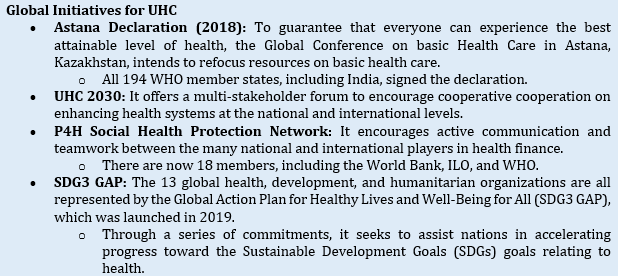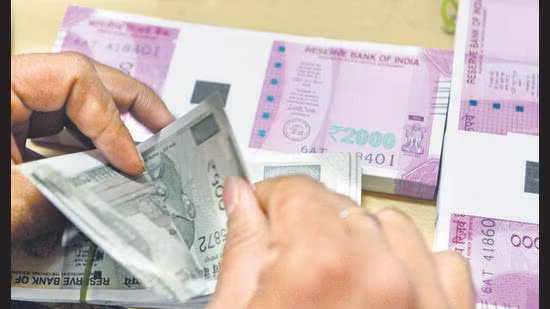- Courses
- GS Full Course 1 Year
- GS Full Course 2 Year
- GS Full Course 3 Year
- GS Full Course Till Selection
- Answer Alpha: Mains 2025 Mentorship
- MEP (Mains Enrichment Programme) Data, Facts
- Essay Target – 150+ Marks
- Online Program
- GS Recorded Course
- Polity
- Geography
- Economy
- Ancient, Medieval and Art & Culture AMAC
- Modern India, Post Independence & World History
- Environment
- Governance
- Science & Technology
- International Relations and Internal Security
- Disaster Management
- Ethics
- NCERT Current Affairs
- Indian Society and Social Issue
- NCERT- Science and Technology
- NCERT - Geography
- NCERT - Ancient History
- NCERT- World History
- NCERT Modern History
- CSAT
- 5 LAYERED ARJUNA Mentorship
- Public Administration Optional
- ABOUT US
- OUR TOPPERS
- TEST SERIES
- FREE STUDY MATERIAL
- VIDEOS
- CONTACT US
Universal Health Coverage Report 2023
Universal Health Coverage Report 2023
21-09-2023
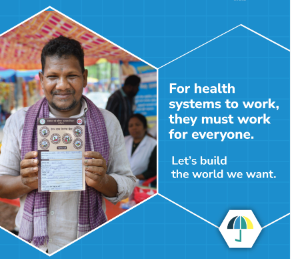
Why in News
- Recently, the 2023 Universal Health Coverage (UHC) Global Monitoring Report launched that provides the latest updates on global progress towards health service coverage (SDG 3.8.1) and financial protection (SDG 3.8.2).
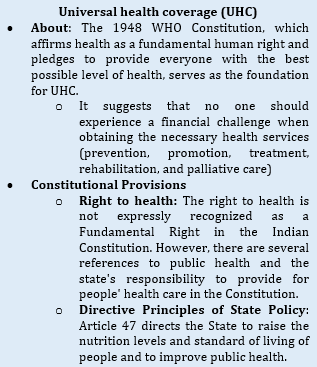
About Universal Health Coverage Global Monitoring Report 2023
- Released by: Jointly by the World Health Organization and the World Bank.
- Indicators: UHC is tracked under 2030 SDGs on two indicators:
- UHC Service Coverage Index (SCI) - Coverage of essential health services.
- Out-of-pocket health Expenditure (OOPE): It measures catastrophic health spending.
- Catastrophic OOPE: It is defined as out-of-pocket expenditure on health exceeding 10% of a household budget.
- Key observations:
- As of 2021, over half the world's population was not fully covered by essential health services.
- Increase in Catastrophic OOPE: from 9.6% in 2000 to 13.5% in 2019.
- It incurs huge opportunity costs in terms of child education and basic human needs.
- Decline in India's SCI score: Declined to 63 in 2021 from 64 in 2019 and 17.5% of people in India suffer from catastrophic OOPE.
- Key Recommendations:
- Implementing a primary healthcare strategy.
- Expansion of key health services
- Removing financial obstacles in the healthcare industry.
- Commitments to international health regulations in acute public health risks.
Significance of UHC:
-
- Improves people’s health: UHC improves population health through more people getting access to a range of effective health services including: preventive, curative, rehabilitative and palliative care.
- Economic benefits of UHC: UHC benefits economies through stimulating economic growth (more productive workforce), facilitating educational gains (healthier children learn better), empowering women and reducing poverty associated with health costs.
- Political benefits of UHC: UHC is popular across the world and if UHC reforms are implemented properly they can build peace and security in countries and deliver substantial political benefits to governments.
- Financial risk protection: Access and use of health services prevents people from being pushed into poverty when they have to pay for health services out of their own pockets.
- Reduce social inequities: Universal health coverage, financed by labor income tax revenue, could reduce inequality due to its large redistributive role.
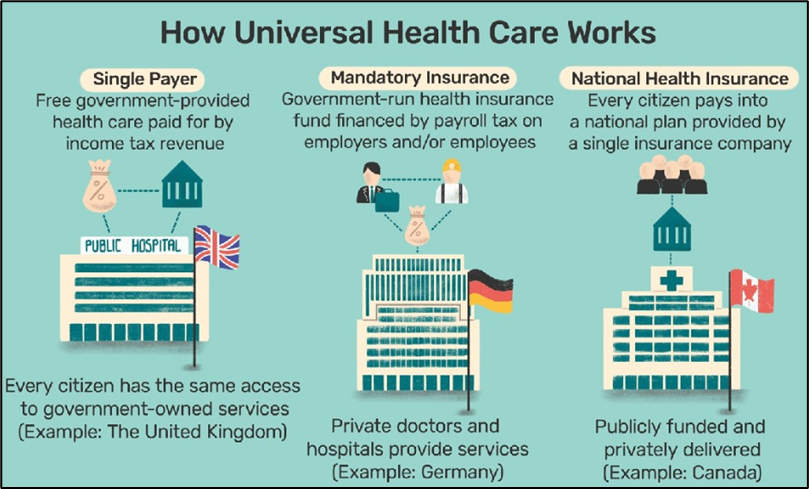
Issues and Challenges in implementing UHC:
-
- Lack of fair access to health insurance: The NFHS-5 statistics show a contrasting picture for India, where households in the lowest wealth quintile had the lowest insurance coverage (36.1%).
- Lack of Financial Protection: In India, there are large differences between states in terms of out-of-pocket costs and access to healthcare services.
- According to the most recent NFHS survey, the average out-of-pocket cost per delivery in a public health facility is Rs. 2,916, which is concurrently Rs. 3,385 and Rs. 2,770 for urban and rural areas.
- Errors in Health Insurance Policies: The Pradhan Mantri Jan Arogya Yojana (PMJAY) is not immune from inclusion and exclusion mistakes, which might result in the inclusion of ineligible families and the exclusion of eligible households, just as prior health insurance schemes.
- Availability of Services: 40% of the hospitals empaneled under the PMJAY are in the private for-profit sector, despite the fact that 56% of the hospitals are in the public sector, indicating that the availability of services may be concentrated in regions with prior experience administering publicly financed health insurance programs.
Way Forward
- Enhancement of Health Expenditure: Currently, 3.2% of India's GDP is allocated to healthcare.
- This is much less than the Lower- and Middle-Income Countries' (LMIC) average health spending share as a percentage of GDP, which is roughly 5.2%.
- Strengthening the primary healthcare sector: Many areas lack primary health care services, and where they do exist, they are often inadequate.
- The creation of health and wellness centers under the Ayushman Bharat plan was recommended in this approach in 2018, although the progress in this area is doubtful.
- Increase Public Investment in Healthcare: Building new healthcare facilities, hiring more healthcare workers, and ensuring there is enough supply of drugs and medical supplies are all part of this.
- Promote Preventive Healthcare: The government should support preventative healthcare initiatives including immunization campaigns, health awareness campaigns, and lifestyle changes.
- Collaboration between the government, healthcare professionals, and civil society: To accomplish UHC, the government should promote collaborations between healthcare providers and civil society groups.
India’s Initiatives for UHC
- National Health Policy 1983: India pledged to achieve "Health for All" by the year 2000 under its National Health Policy from 1983.
- National Health Mission (NHM): The National Urban Health Mission (2013) and the National Rural Health Mission (2005) were combined into it to attain universal access to just, affordable, high-quality healthcare services that are responsible and sensitive to the requirements of the public.
- National Food Security Act (NFSA): To guarantee that people have access to adequate high-quality food at affordable costs, the Union Government offers food grains at a cheap cost through the NFSA.
- Ayushman Bharat Pradhan Mantri Jan Arogya Yojana (AB PM-JAY): The Union Government launched AB PM-JAY in 2018 as a step toward Universal Health Coverage (UHC), which is the ultimate goal.
- Saksham Anganwadi & Poshan 2.0: This integrated nutrition support program seeks to address the challenges of malnutrition in children, adolescent girls, pregnant women, and lactating mothers.
